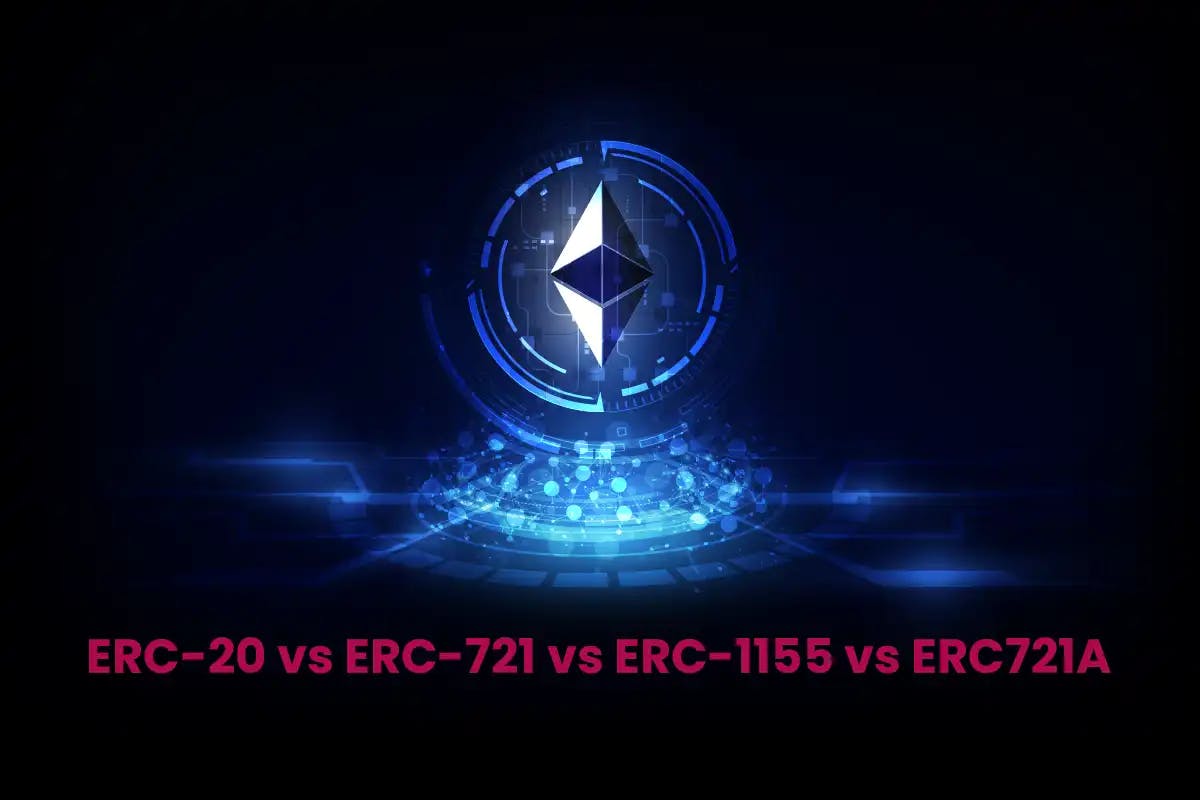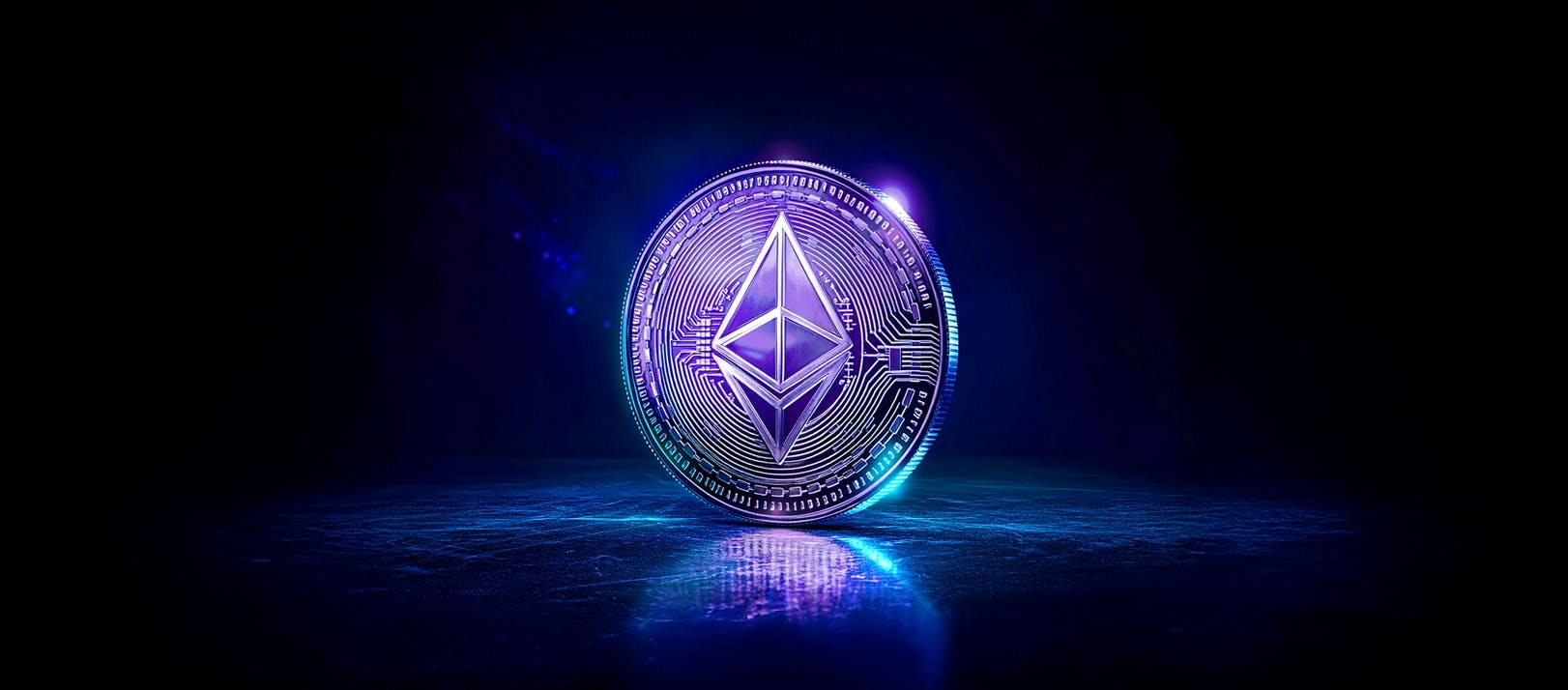
,
Blockchain technology has come a long way since the introduction of Bitcoin, and Ethereum has emerged as a leading platform for decentralised applications. One of Ethereum's breakthroughs was the concept of smart contracts, which opened up new opportunities for programmable tokens.
In this article, we will explore four important Ethereum token standards: ERC-20, ERC-721, ERC-1155, and ERC721A. We'll discuss their significance and nuances in depth in terms of blockchain development.
So, buckle up as we’re about to take a deep dive into the world of Ethereum blockchain.
What is Ethereum blockchain?
These self-executing agreements have their terms directly written into code and can interact with the Ethereum network. They play a vital role in the development of decentralised applications (DApps). Ether (ETH) is Ethereum's native cryptocurrency, used as fuel for executing these smart contracts. Tokens on the Ethereum network represent assets, governed by different token standards that define their creation and functionality.
It is important to understand the distinctions and applications of each token standard within the Ethereum ecosystem. Each standard serves a specific purpose.
Prominent Ethereum token protocols
Let’s explore the four major Ethereum token standards and how they are used by the blockchain development company:
- ERC-20 Tokens
These tokens are interchangeable and widely utilised in different financial applications and crowdfunding initiatives. - ERC-721 Tokens
These tokens are a type of non-fungible token (NFT) that represent ownership of unique and indivisible assets. These tokens are commonly used in digital collectibles, gaming, and art. - ERC-1155 Tokens
This standard combines elements from both ERC-20 and ERC-721. It empowers developers to effortlessly create tokens that can be either fungible or non-fungible, all within a single smart contract. - ERC721A Tokens
They are a modified version of the ERC-721 standard, incorporating various enhancements to improve efficiency and versatility.
ERC-20 Tokens
What is the ERC-20 Standard?
Ethereum Request for Comment 20, i.e. ERC-20 is the most commonly used token standard on the Ethereum network. This set of rules and protocols are used by Blockchain developers to develop and execute tokens on the Ethereum Blockchain. These tokens, known as ERC-20 tokens, are interchangeable, meaning each token is indistinguishable from another of the same kind. They also allow users to hold fractional amounts by being divisible.
Use Cases of ERC-20 Tokens
ERC-20 tokens are used in various applications by blockchain development company, including:
- Cryptocurrencies
Many popular cryptocurrencies like Chainlink (LINK), Binance Coin (BNB), and Tether (USDT) are ERC-20 tokens. - Fundraising
Initial Coin Offerings (ICOs) often use ERC-20 tokens as a means to raise capital. - DeFi
Decentralised Finance (DeFi) platforms use ERC-20 tokens for lending, borrowing, and trading.
Pros and Cons of ERC-20 Tokens
Pros of ERC-20 Tokens
- Interoperability
ERC-20 tokens can be easily integrated with a wide range of wallets, exchanges, and platforms. - Accessibility
The simplicity of ERC-20 makes it accessible for both developers and users. - Liquidity
High liquidity due to widespread use in the crypto ecosystem.
Cons of ERC-20 Tokens
- Fungibility
While beneficial in many cases for blockchain development services like interoperability, smart contract compatibility, crowdfunding & token sales, and more, fungibility can be a limitation when representing unique assets. - Lack of Standards
ERC-20 tokens have varying levels of functionality, leading to inconsistencies in user experiences. - Vulnerabilities
Poorly coded ERC-20 contracts can be vulnerable to hacks.
ERC-721 Tokens
What is the ERC-721 Standard?
The ERC-721 standard, also known as the "Non-Fungible Token (NFT)" standard, was a major advancement in the Ethereum blockchain ecosystem. It was introduced to overcome the limitations of fungible tokens like ERC-20 and revolutionised digital asset creation by allowing for unique and indivisible assets.
At its core, the ERC-721 standard transformed the way we define ownership and value in the digital world. Unlike ERC-20 tokens, which are largely interchangeable, each ERC-721 token is unique, much like a digital snowflake. This uniqueness is what makes NFTs so influential and enables their widespread usage and innovative advancements.
Use Cases of ERC-721 Tokens
ERC-721 tokens have found application in:
- Digital Collectibles
CryptoKitties and NBA Top Shot are notable examples of digital collectibles represented as ERC-721 tokens. - Gaming
NFTs are used in gaming to represent in-game assets like skins, characters, and weapons. - Art and Music
Artists and musicians use NFTs to sell unique digital creations.
Pros of ERC-721 Tokens
- Ownership and Provenance
NFTs provide clear ownership records and provenance of unique assets. - Scarcity
NFTs are ideal for representing rare and limited-edition items. - Diverse Use Cases
The versatility of NFTs allows for applications in various creative industries.
Cons of ERC-721 Tokens
- Limited Fungibility
The lack of fungibility can make ERC-721 tokens less suitable for certain financial transactions. - Scalability
High gas fees and network congestion can limit the efficiency of ERC-721 transactions. - Counterfeiting Concerns
Ensuring the authenticity of NFTs is a challenge.
ERC-1155 Tokens
What is the ERC-1155 Standard?
The ERC-1155 standard is a standout token standard in the Ethereum ecosystem. It offers blockchain development companies a versatile and adaptable toolkit for creating and managing tokens. What makes ERC-1155 special is its ability to combine the best features of both ERC-20 (fungibility) and ERC-721 (uniqueness).
In simple terms, ERC-1155 allows developers to create and manage multiple tokens using one smart contract. This not only improves efficiency but also streamlines the development process to provide a unified solution for different purposes.
Use Cases of ERC-1155 Tokens
ERC-1155 tokens are employed in scenarios like:
- Gaming
ERC-1155 allows game developers to create in-game currencies (fungible) and unique in-game items (non-fungible) in a single contract. - Marketplaces
It simplifies the creation of platforms that support various asset types. - Digital Collectibles
Offers flexibility in representing both common and rare collectibles.
Pros of ERC-1155 Tokens
- Versatility
One contract can manage a combination of fungible and non-fungible assets. - Efficiency
ERC-1155 can optimise gas costs by batching multiple token transfers in a single transaction. - Simplified Development
Developers have the flexibility to choose the appropriate token type within the same contract.
Cons of ERC-1155 Tokens
- Complexity
The versatility of ERC-1155 can make the development process more intricate. - Compatibility
Not all wallets and platforms support ERC-1155 tokens.
ERC721A Tokens
What is the ERC721A Standard?
The ERC721A standard is a notable advancement in the world of non-fungible tokens (NFTs) and smart contract standards. It builds upon the foundation set by its predecessor, ERC-721, and introduces valuable improvements to enhance the functionality, usability, and overall efficiency of non-fungible tokens.
The introduction of batch transfer capabilities, royalty support, and enhanced metadata management tackles important challenges in the NFT space. These advancements aim to improve efficiency, prioritize creators' needs, and cater to user preferences. As the NFT ecosystem continues to develop, ERC721A plays an important role in shaping the future of digital ownership and monetizing creative content on the blockchain development space.
How ERC721A Improves upon the ERC-721 Standard
ERC721A introduces several improvements:
- Batch Transfer
This feature allows multiple tokens to be transferred in a single transaction, reducing gas costs. - Royalty Support
Creators can receive a percentage of secondary market sales of their NFTs. - Metadata Storage
Improved metadata management ensures better token representation.
Use Cases of ERC721A
ERC721A can be particularly beneficial in scenarios where optimised gas costs and enhanced features are required:
- Art and Collectibles
Artists can benefit from royalty support on secondary sales. - Gaming
The efficiency of batch transfers can enhance in-game asset management. - Marketplaces
Better metadata management and royalties can attract creators and collectors.
A Comparative Analysis of ERC 20 vs ERC 721 vs ERC 1155 vs ERC721A
Let's compare the four Ethereum token standards in tabular format:

Real World Examples of Ethereum's Token Standards
As we move forward in this piece of content, let’s shift our focus on understand the practical applications of these token standards with some real-world examples:
Uniswap (ERC-20)
Uniswap has emerged as a leading decentralised exchange (DEX) that operates on the Ethereum network. This platform enables users to conveniently swap different ERC-20 tokens directly from their wallets, making it a preferred choice for cryptocurrency trading.
Usage of Uniswap (ERC-20)
UNI, the governance token of Uniswap, is built on the ERC-20 standard. This token plays a vital role in governing and shaping the Uniswap protocol. Holders of UNI have the authority to vote on proposals and influence changes within the Uniswap ecosystem. In essence, it empowers users to actively participate in decentralised decision-making processes on the platform.
Importance of Uniswap (ERC-20)
Uniswap's utilisation of ERC-20 tokens showcases the widespread acceptance of these tokens as essential elements for governance and functionality within DeFi projects.
CryptoKitties (ERC-721)
CryptoKitties is often recognized as one of the pioneers in blockchain-based gaming. It enables players to collect, breed, and trade unique digital cats that are represented as ERC-721 tokens. Each CryptoKitty is a non-fungible token (NFT) with distinct traits, making these virtual felines highly coveted collectibles.
Usage of CryptoKitties (ERC-721)
CryptoKitties utilise the ERC-721 standard to represent each digital cat as a unique and non-interchangeable token. This distinctiveness and verifiable scarcity are what make the game intriguing and valuable.
Importance of CryptoKitties (ERC-721)
CryptoKitties played a significant role in showcasing the potential of blockchain and NFTs in the gaming and collectibles sector. This pioneering project sparked the NFT craze and served as inspiration for numerous similar ventures.
Enjin Coin (ERC-1155)
Enjin Coin is a platform and cryptocurrency that operates on the blockchain. Its main goal is to establish a metaverse, a virtual reality where in-game assets and collectibles are transformed into digital tokens. This platform offers developers a range of tools to easily create, manage, and integrate non-fungible tokens (NFTs) into games.
Usage of Enjin Coin
Enjin Coin employs the ERC-1155 standard for issuing both fungible tokens, which serve as in-game currency, and non-fungible tokens for unique in-game assets. This approach offers flexibility, enabling various applications and streamlined asset management.
Importance of Enjin Coin
Enjin Coin showcases the potential of the ERC-1155 standard in streamlining the incorporation of blockchain technology within the gaming industry. This advancement enables developers to craft more engaging and immersive gaming experiences.
SuperRare (ERC721A)
SuperRare is an online art platform that utilises blockchain technology to enable the sale and trade of digital artworks as NFTs (non-fungible tokens). Artists can create and authenticate their artwork as NFTs, which collectors can then buy and trade as unique digital assets.
Usage of SuperRare (ERC721A)
SuperRare uses the ERC721A standard for its NFTs, which brings several enhancements. This upgraded standard enables batch transfers and royalty support, allowing artists to receive continuous revenue streams from their art. Additionally, metadata management is improved, ensuring a more seamless experience for users.
Importance of SuperRare (ERC721A)
SuperRare demonstrates how the ERC721A standard can empower creators in the digital art industry. It offers a sustainable method for artists to monetize their work and ensure their continued involvement in the resale of their pieces.
Future Trends of Ethereum's Token Standards
Three significant trends and developments in the world of Ethereum token standards include:
Cross-Chain Compatibility of Token Standards
As the blockchain ecosystem continues to expand, there has been a growing need for cross-chain compatibility. This trend focuses on fostering interoperability between Ethereum and other blockchains, allowing assets like tokens to move seamlessly across different networks. With various chains offering unique features and capabilities, this compatibility becomes crucial in enabling efficient transfers of assets between different blockchain networks.
To achieve this, bridges and interoperability solutions are utilised. These bridges serve as connectors, linking Ethereum with other blockchains such as Binance Smart Chain, Polkadot, or Solana. They enable assets to be securely transferred from one chain to another by locking them on one chain and issuing equivalent tokens on the target blockchain. For instance, tokens based on ERC-20 or ERC-721 standards in Ethereum can now be employed within these alternate blockchains, revealing a wide range of new use cases and facilitating broader adoption.
Fractional Ownership of Token Standards
Traditionally, NFTs are indivisible and represent unique, often high-value assets like digital art or rare collectibles. However, fractional ownership platforms are now enabling investors to purchase fractions or shares of NFTs.
Regulation and Compliance of Token Standards
Regulators and policymakers are taking notice of the rise in prominence of NFTs and blockchain assets. Regulation in the NFT space covers various aspects, including protecting consumers, preventing money laundering, and ensuring tax compliance. It is crucial to ensure that NFTs comply with legal and tax obligations in order to uphold credibility and legitimacy within the industry.
Conclusion
So, as we wrap up this topic, remember that Token standards are essential in the Ethereum ecosystem as they impact how assets are generated, controlled, and exchanged. Four key standards - ERC-20, ERC-721, ERC-1155, and ERC721A - serve as the foundation for decentralised applications and digital assets. Each standard brings its own benefits and limitations, addressing various use cases. That’s exactly where Codiste comes into play. Being a Top blockchain development company, we help blockchain development companies, investors, and enthusiasts to comprehend these standards along with their roles within the constantly evolving blockchain technology landscape.
As Ethereum and its ecosystem progress, the standards for tokens will evolve to align with the dynamic landscape and we can help you to unleash the complete power of these tokens. These token standards on Ethereum pave the way for innovation in various areas such as fungible assets, non-fungible collectibles, versatile contracts, and efficient royalties. This enables limitless opportunities for creative advancements within the blockchain world.




